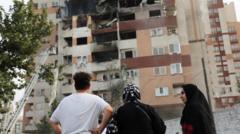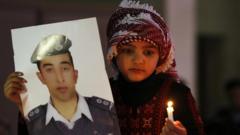In the aftermath of the Assad regime's collapse, residents of Latakia, particularly from the Alawite sect, are left on edge as new rulers, Hayat Tahrir al-Sham (HTS), attempt to fill the power vacuum. With incidents of violence and property disputes rising, many fear retaliation for their previous loyalty to the regime.
Uncertainty Reigns in Alawite Heartland After Regime Change in Syria

Uncertainty Reigns in Alawite Heartland After Regime Change in Syria
As Hayat Tahrir al-Sham establishes its authority in Latakia, the Alawite community grapples with fear and uncertainty following the fall of the Assad regime.
As the sun sets on the once-secure neighborhoods of Latakia, fear casts a long shadow over the Alawite heartland. This past week, a woman, known only as Noor, approached the Hayat Tahrir al-Sham (HTS) forces, Syria’s new governing authority. She trembled not from the biting cold but from the chilling recount of her distressing experience. Just days earlier, armed men in a black van had invaded her home, displacing her family, and moving in as if they owned the place.
Noor, an Alawite woman reflecting the mindset of her community, is living in anxiety as she confronts the new realities in Syria. Alawites, who represent a minority sect originating from the Assad lineage, have historically comprised about 10% of Syria's population, which is predominantly Sunni. The coastal city of Latakia serves as their stronghold, but with the rapid changes affecting the area, many in Noor's community are gripped with fear.
With various rebel factions stepping into the void left by Assad’s military withdrawal, the landscape of governance has dramatically altered. HTS, which once had affiliations with al-Qaeda, now finds itself navigating the complexities of governance and law enforcement. Noor’s encounter with HTS commander Abu Ayoub showcases the shifting power dynamics, as he pledges to restore her rights and possessions after her home was overtaken.
In recent weeks, Latakia has transformed into a hotbed of erratic incidents as both civilians and former regime loyalists encounter HTS forces. Noor is just one among numerous complainants who come seeking justice, confronting a newly minted police force that is struggling to enforce order amidst a backdrop of chaos and lawlessness. Others tell tales of intimidation, where family members are threatened with weapons and their belongings stolen in the frenzy of post-revolution plunder.
Despite HTS's declarations of upholding peace and religious mutual respect, the apprehension among the Alawites remains palpable. Many have hesitated to leave their homes, fearing retribution for their previous allegiance to the Assad administration. Noor’s testimony symbolizes a broader unease, rooted in decades of sectarian division fostered by the Assad regime.
As HTS attempts to stabilize its authority, they are met with skepticism and fear from segments of the population. The newly emerging symbols of unity celebrated after the regime's fall contrast starkly with the silent anxieties of Alawite residents who feel cornered by recent changes. Historic loyalties and vulnerabilities have left many feeling isolated, raising the question if true security can ever be regained.
Confronted by rising hostilities and new governance, Noor laments the loss of her peace of mind, feeling a mix of fear and hope as she navigates this precarious new chapter. The transformation in Latakia is not solely one of power, but of human emotion, as communities grapple with the profound implications of this regime change.






















